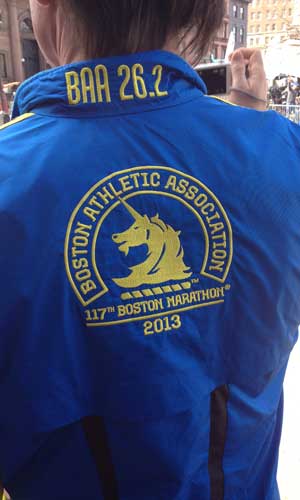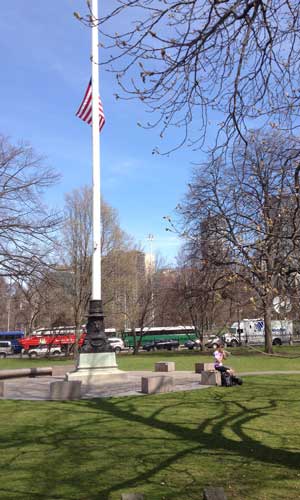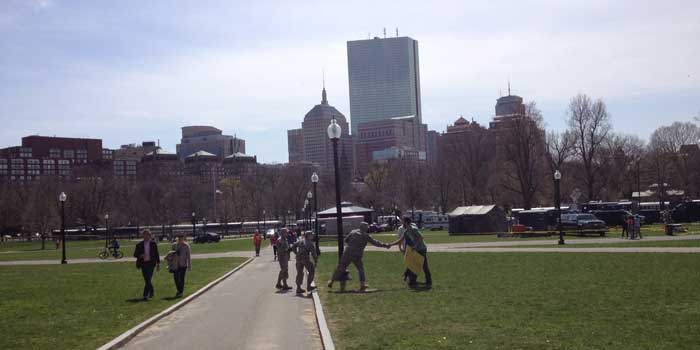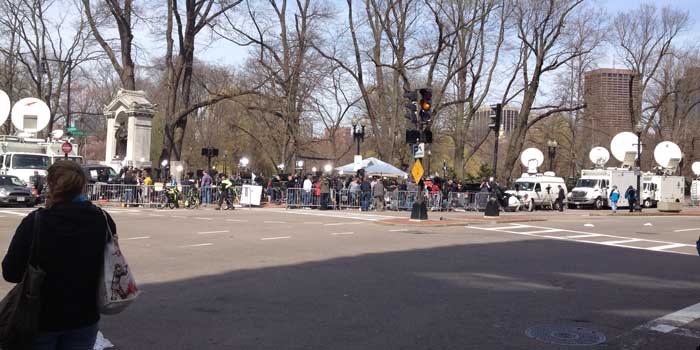“Cubes” by Jon Brion from I Heart Huckabees, on repeat.
On a very cold afternoon in January 2003, my life involved wandering around Derry, Northern Ireland, with a very tall man called Big John. In what was formally referred to as a guided tour and informally a walk down memory lane, Big John walked us through where Bloody Sunday (Bogside Massacre) happened. It’s not just a U2 song, apparently, although it’s strange and a bit shameful to have first learned about this atrocity by something that was on the Top 40, and something that I vacantly enjoyed before realizing the horror of its inspiration. Thus is the mystery of art, I supposed. I was just a child when singing to this song. But I still think of this massacre song first, blood and lost innocence later.

It’s a strange shame, the song-first shame. There are different variants of it as well. The kind most Americans are guilty of is first-world shame. We read about bombings and atrocities in other countries, pore over photos, do our best to negotiate our complicated response of shock and horror, sadness, gratitude, morbid curiosity, blame, comeuppance, relief and such.
But these things happen here, too. Bombings, shootings, murder.
On Tuesday, I was in Boston and felt a duty to walk to Copley Square—or as close as I could get—and bear witness. At least that’s what I called it. But mostly, though, I just felt this urge to go. I struggled with this feeling of wanting to go there. I feared it might be disrespectful, my presence being tantamount to gawking at misery, tantamount to pointing and staring.
If only I was a Boston resident, I thought. Then I’d feel more of a right to be there, not so much like a tourist or, worse yet, sick. And then I started seeing the jackets.
I was told that I’d see these jackets. At $100 a piece, they are the color of something the Adidas site calls “prime blue.” They add that it’s “climaproof” and “features a full zip with a standup collar.” But mostly, there’s the sun-yellow Boston Marathon badge, expansive and electric on the back as well as across the heart. These are the official jackets worn by the runners of the Boston Marathon.
When I saw my first prime blue, I was still in a coffee shop. I scurried for my camera. “No, don’t take a picture,” scolded my coffee talk companion. “You’re going to see them all over.”

All over they were. And the closer I got to Copley Square, the more of them there were. But first I had to get there. This meant me, phone in hand, walking like an idiot, trying to not look it. That didn’t work, especially as I was forced to do two about-faces on Cambridge Ave. Twice. That’s four times where I walked a little bit, slowed, looked at my phone, paused, turned around, paused, noticed people noticing me, and so on. People actually looked at me, but with a smile. Thankfully, I saw a Red Cross sign with an arrow pointed toward a door. Donating blood. Of course! I bounded in and had to wait in line only to be turned away. They were no longer accepting walk-ins, but there might be hope in a couple days. Even then, it would be better if I were to make an appointment, but there were no guarantees. My lip trembled. I was overwhelmed, and the security guy who told me beamed. “Pretty cool, huh.” Cool, indeed.
Back on the outside, I was now walking up the very steep Joy Street. I snapped photos and selected music while walking. Shuffle was failing me miserably, unfortunately. At one point, “The Gravel Road” from M. Night Shyamalan’s The Village was playing. That just wasn’t right. Another time, music from a masturbating scene in American Beauty. Finally, a song I’ve heard on This American Life surfaced. I hit repeat, and that was to be my soundtrack for the day. Sweet, ruminating, melancholy, TAL-evoking—it was the right song.
From the top of the hill, I crossed Beacon Street and entered a park. Prime Blue jackets everywhere. I just couldn’t believe it. I wanted to hug them. I wanted to give my condolences. I wanted to listen to their stories. Instead, I took their pictures and felt bad about it. But then there was the yellow and black police tape. This is where it’s beginning, I thought.
I knew that I wouldn’t actually get to Copley Square. I also knew that there were many, many streets blocked off. But it started so soon, the police tape and blockades. And there were so many military and police. Such a strange mix of prime blue jackets with what I now call police tape yellow Adidas stripes and Boston Marathon badges. Regular folk sitting on blankets in the park, reading and relaxing in the sun. An old woman ripping open an envelope while sitting on a park bench. A young man playing a trombone in front of a flag flying half-staff. A homeless man napping on another park bench. A couple 20-somethings holding posters with words “Boston” and “Prayer” on it, shaking hands with a trio of soldiers in fatigues drinking coffee. Military Humvees, mobile cell sites, Red Cross disaster relief vehicles, tinted windows on black vehicles, bomb units, the FBI—the park was Boston Commons, and it was the staging area for the investigation. It was the boundary zone. Like sun burning off the morning fog that will return, seeing these vehicles emulsified denial. You have to see it to believe it, goes the saying.
Crossing the Commons, I was stuck in a small herd of prime blues and regular folk. We were held back to wait for two Red Cross vehicles to back up into this cordoned off area. They looked like ambulances with “Disaster Relief” splayed on the sides. Why were they being moved to a park and not placed back into wherever they go? After the bomb threats on Wednesday, I wonder if those trucks and more like them will be sitting idle but conveniently located.
As I neared Boylsten Street, I started noticing reporters and all their equipment and vehicles. Scrums of prime blues being interviewed on camera dimpled the way. At times, there were more reporters than regular people, cars even. CNN, NPR, BBC, Canadian something or rather—so many news outlets from all over the world. Different accents, different languages, it was unlike anything I’ve ever been around. Across the street from me was a news conference. One woman in front of at least 50 people, disks of white hot lights shone down, cords and cables and equipment clotted together like a creature in one corner of a park on a blue skied, sunny day. I walked on.
By this time, my phone had 10% of its battery left. I sat down to quickly (and unsuccessfully) draw a map for my return. Without realizing it, I had chosen a place where I was, yet again, outnumbered by reporters. A man with a British accent was reporting that one of the bombs was made out of a pressure cooker. This was news to me. I looked out at one of the many ominous white tented areas blocks away, obscuring the horrible underneath. If only I could get closer, I thought.
Several days after my sister died in a car accident—and I think this was before the funeral—we drove to the field where she had passed away. The car had rolled several times, and she had flown out of the window. No seat belt. She was found sitting up against a little wooden shed housing square troughs for cow feed. We think that while the head trauma ultimately killed her, she had some time to pull herself up to the shed before she lost consciousness. The paramedics were able to revive her, something that later allowed us to donate her organs.
I remember walking around the field that day, scouring the ground for things of hers. We found pieces of the car, a frog she always had on the dashboard, tracks and uprooted grass. Later we took out cans of spray paint (I have no idea who brought that and don’t think we planned on it) and marked that area of the road with her name and ours.
While I’m painfully sensitive to the idea of being respectful of such hallowed ground, I’m also equally sensitive to the power of place and what it means to be connected. We ask questions, we stare, we sit in silence and open letters and nap and play the trombone. I think we mainly just want to feel connected, that in such times as these when it’s very difficult to navigate what’s the right thing to do, when bad things happen, more than ever we just want to be close enough to make it real to ourselves. And then, so we can have proximity with each other, so we can be close, close enough for a hug, close enough to be considered one.

